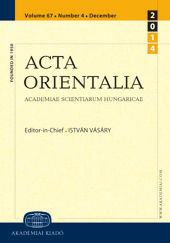What Connects Mongol Rulers with the Chinese World: Imperial Edicts, a Literal Translation Style, and Spoken Chinese
What Connects Mongol Rulers with the Chinese World: Imperial Edicts, a Literal Translation Style, and Spoken Chinese
Author(s): Yoshiyuki FunadaSubject(s): Ancient World
Published by: Akadémiai Kiadó
Keywords: Mongol Empire; Yuan Dynasty; zhiyi-ti (literal translation style); Lao Qida; translation; language contact; Sino-Mongolian; Mongolo-Chinese
Summary/Abstract: This study examines the influence of Mongolian language on spoken Chinese, with a focus on the Sino-Mongolian, or Chinese language translated using the literal translation style (zhiyi-ti 直譯體) from Mongolian. Sino-Mongolian was a type of contact language, based on the Chinese vocabulary and Mongolian syntactic structure. Common linguistic elements are observed between Sino-Mongolian and the Chinese textbook No Gŏltae edited in the Koryŏ Kingdom under Mongol rule. The analysis confirms that No Gŏltae was not translated from Mongolian language but a type of spoken Chinese that was influenced and shaped by Sino-Mongolian through oral dissemination. Although Sino-Mongolian was an artificially translated language, the literal translation style may have been based on Altaic Pidgin Chinese. Hence, it was readily accepted in Northern China and naturally influenced and shaped the spoken Chinese there. It is concluded that the colloquial Chinese influenced by Sino-Mongolian, as observed in No Gŏltae, would be defined as Mongolo-Chinese, a type of Creole language.
Journal: Acta Orientalia Academiae Scientiarum Hungaricae
- Issue Year: 77/2024
- Issue No: 3
- Page Range: 415-431
- Page Count: 17
- Language: English
- Content File-PDF

